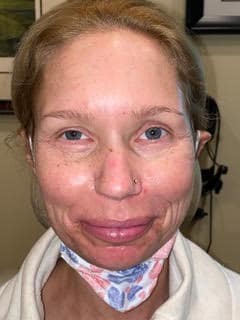Ptosis
Eyelids That Droop
A drooping eyelid is called ptosis or blepharoptosis. In ptosis, the upper eyelid falls to a position that is lower than normal. In severe cases of ptosis, the drooping eyelid can cover part or all of the pupil and interfere with vision, resulting in amblyopia. Treatment of Ptosis is usually a Blepharoplasty Surgery.
At Rizzuto Eyelid & Facial Plastic Surgery, board-certified Oculofacial Plastic Surgeon Dr. Rizzuto, is proud to offer blepharoplasty surgery to patients looking to correct ptosis or improve the appearance of their eyes and enhance overall vision.
What Causes of Ptosis?
Ptosis, also known as drooping eyelids, happens when a person's upper eyelid (in some cases, both upper eyelids) lies sagged or drooped over the eye. In mild cases of ptosis, this may be just a cosmetic issue, but in more moderate to severe cases of ptosis, it can lead to serious functional problems.
While the causes of ptosis will vary from patient to patient, common causes include the following:
Age: The muscles responsible for holding the eyelids up can weaken with age and lead to ptosis.
Genetics: Some individuals may be at higher risk of ptosis due to hereditary factors.
Muscle or nerve trauma - Damage caused by physical injury or even neurological conditions can lead to weakened muscles that result in ptosis.
Eyelid tumors: One reason to always have ptosis checked by a medical professional is because it may be caused by a tumor or cancerous growth that needs to be removed.
Medical symptom or medication side effect: Some medical conditions like Horner's syndrome and some medications like those for glaucoma can result in ptosis as a symptom or side effect.
What Are the Symptoms of Ptosis?
Recognizing symptoms of ptosis in the eye can be essential when it comes to your ocular health. While the most obvious symptom of ptosis is the drooping eyelid, the following eye conditions can also be a symptom of ptosis:
Impaired vision: Because the eyelid droops lower, it obstructs one's visual field. This can make it hard to complete daily activities like driving.
Eye strain and fatigue: Having to lift your eyelid higher to maintain clear vision consistently can and will cause strain and fatigue on the eye as well as the muscles around the eye.
Forehead wrinkling: In order to improve vision, individuals with ptosis sometimes tilt their heads sideways or upwards to help adjust the angle of vision. This causes forehead wrinkles.
Double vision: Also known as diplopia, double vision can occur when the eyelid droops down so far as to disrupt the natural alignment of the eyes, thereby leading to overlapping images.
Irritation: The constant sliding and drooping of the eyelid low over the eye can result in excessive eye irritation. This may lead the eye to feeling dry, gritty, and otherwise irritated.
Headaches and migraines: The above symptoms, especially eye fatigue, can likewise result in increased headaches and migraines as the brain tries to compensate for the condition.
How Is Ptosis Diagnosed?
Ptosis can be diagnosed after an ophthalmologist provides a thorough review of your eyelids and if or how it affects your vision. Your medical history and genetics may also be considered. A full eye exam, a CT scan, and an MRI scan, as well as blood tests, may also be used to diagnose ptosis.
How Is Ptosis Treated?
To treat ptosis, a blepharoplasty or eyelid surgery will be recommended for most healthy adults and children whose overall vision is affected by ptosis or if their symptoms have worsened over time. The surgery will focus either on tightening the levator muscle around the eye or the attaching of the eyelid to other muscles that can help lift the eyelid to improve vision.
What Happens If Ptosis Is Left Untreated?
If ptosis is left untreated, the eyelids may droop low enough to cover a patient’s pupil and block their vision. Untreated ptosis may also lead to poor vision, the development of amblyopia or the "lazy eye," astigmatism, and, in severe cases, complete blindness.
Are There Any Non-Surgical Alternatives to Treating Ptosis?
For some patients, non-surgical treatments can be used to improve ptosis symptoms. These treatments may include:
- Dermal fillers such as Bellafill, Restylane, RHA Fillers, and Sculptra
- BOTOX brow lift or eye lift
- Facial exercises that focus on lifting the forehead area
Whichever treatment option you decide to choose, the team at Rizzuto Eyelid and Facial Plastic Surgery is prepared to help you at each step of the way.
Schedule a Consultation at Rizzuto Eyelid and Facial Plastic Surgery in Middletown and Providence
If you are experiencing any symptoms of ptosis or have already been diagnosed with ptosis, you can schedule a consultation with Dr. Rizzuto to discuss your treatment options. We can get you a more permanent solution to greatly improve your vision and overall appearance. With convenient locations in Middletown and Providence, we are proud to serve patients all across Rhode Island. To book a consultation, click here or call (401) 274-6622 .


